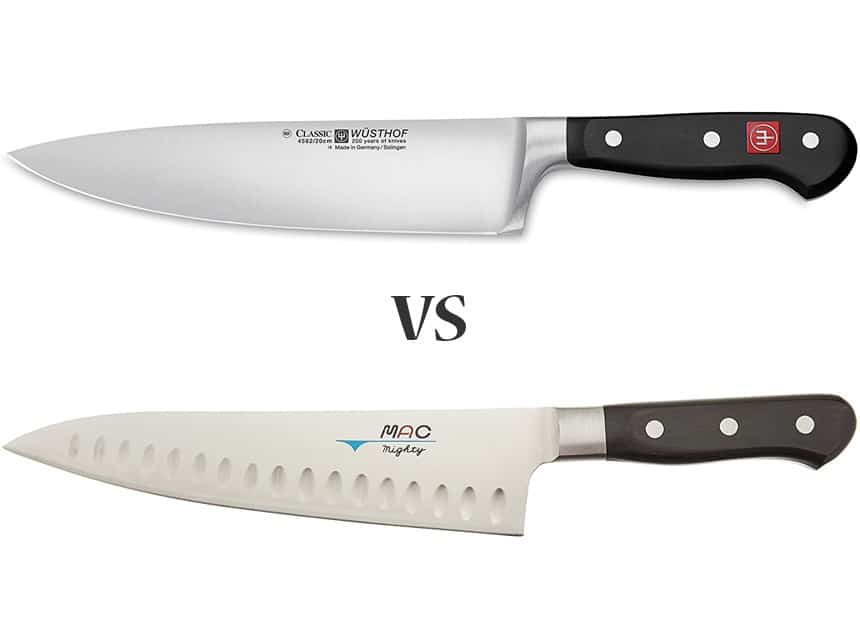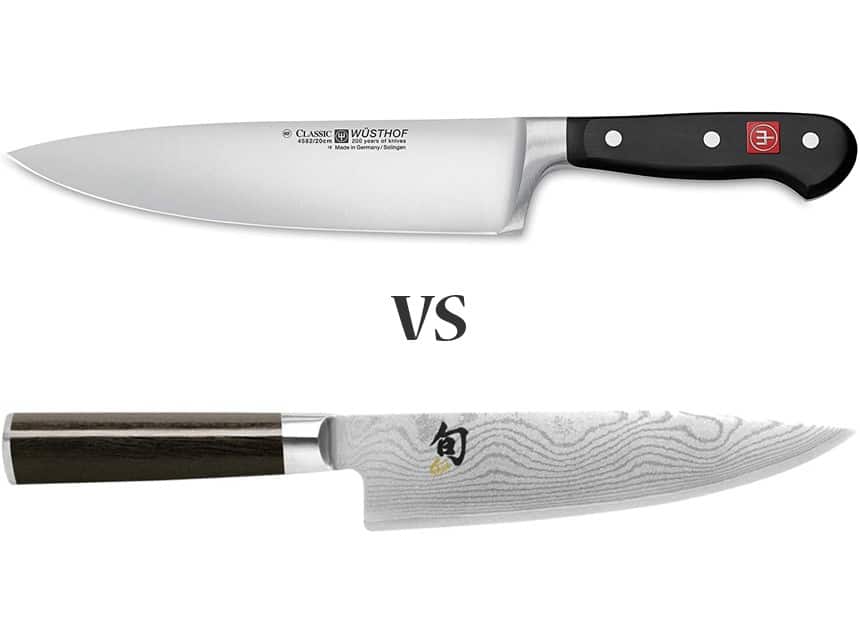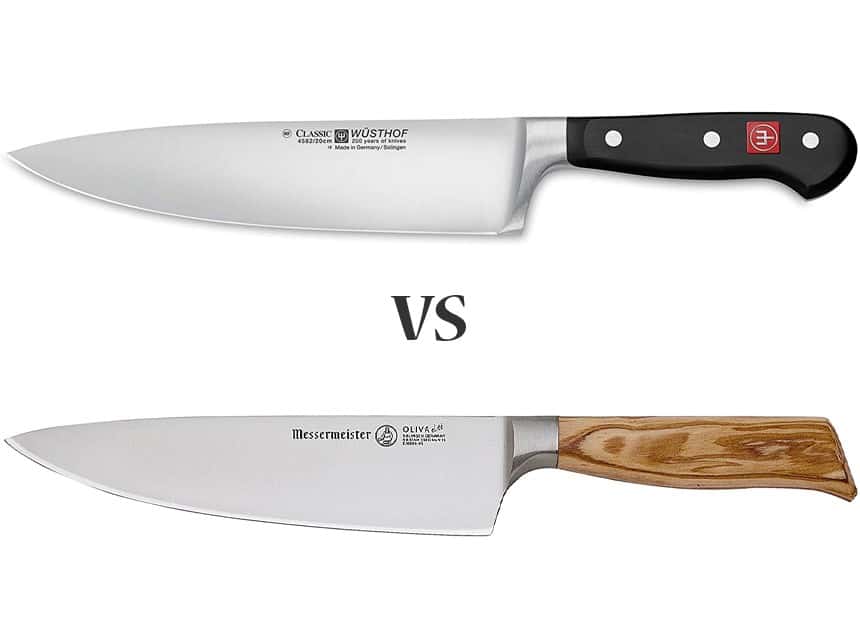
Choosing the correct kitchen knife for you can be tricky.
A good knife can last for decades so it’s worth taking the time to research any knife before you buy it.
Two great brands people are often deciding between are Wüsthof and Mac.
In this article, I’m going to tell you the differences between these two great brands. I’ll go in-depth into the details of each, talking about where they are made, what materials are used and the difference in price.
This should be all the information you need to select your perfect knife.
For those with busy family kitchens, the durability of the Wüsthof would probably be preferable as the Mac knives are more prone to chipping along the edge. But for those who are confident they can store the knife carefully then Mac knives offer a superior, sharper cutting edge.
| My recommendation | Current price |
| Wüsthof Classic 8-Inch | View on Amazon (opens new tab) |
| Mac Professional 8-Inch | View on Amazon (opens new tab) |
Wüsthof vs Mac – Comparison Table
Here is my summary comparison table for each brand. This is mostly based on their main range of knives; the Wüsthof Classic and the Mac Professional.
For a more in-depth look at each category then check out the rest of the article below.
| Category | Wüsthof | Mac |
| Country of Manufacture | Germany | Japan |
| Steel type | X50CrMoV15 | VG-5 |
| Rockwell hardness | HRC 58 | HRC 59-61 |
| Factory edge | 14 degrees (double bevel) | ~15 degrees (double bevel) |
| Handle material | POM (thermoplastic) | Pakkawood (wood/resin composite) |
| Price range | $150 – $170 (Classic) | $160 – $180 (Professional) |
| Main benefit | More durable | Sharper |
| My recommendation | 8-Inch Classic (view on Amazon) | 8-Inch Professional (view on Amazon) |
Wüsthof vs Mac – Where are they made
| Brand | Country of Manufacture |
| Wüsthof | Germany |
| Mac | Japan |
Wüsthof is a family-owned German company based in Solingen, a city based just outside Düsseldorf in Western German.
Wüsthof produces all its knives in the German city of Solingen and has done so for over 200 years. This relatively small German city has a population just above 150,000, its strong knife making reputation has led it to be dubbed ‘The City of Blades’.
Mac is a Japanese company with a strong presence both in the USA and Japan. Its American HQ is in Sacramento, California, with its head office located in Sakai, Japan.
All Mac knives are manufactured in the Japanese city of Seki. Seki is known as the knife capital of Japan, with a population of only 90,000 it lies around 150 miles from Toyoko but is the central hub for all of Japan’s major knife manufacturers.
Mac has been making knives since 1964, selling over 25 million of their fantastically designed East-meets-West knives.
As you can see, both of these knives are manufactured in locations rich in knife making history, both these knives are the genuine article, they do not use cheap foreign labor but instead are true to the heritage of both German and Japanese knife making.
Wüsthof vs Mac – What steel do they use
The steel used in knives will often change depending on which range you pick.
Here I’m going to focus on the most popular range for both Wüsthof and Mac knives.
For Wüsthof that’s their ‘Classic’ range and for Mac it’s their ‘Professional’ range, sometimes referred to as their ‘Mighty’ range.
| Brand | Steel type | Rockwell hardness |
| Wüsthof Classic | X50CrMoV15 | HRC 58 |
| Mac Professional | VG-5 | HRC 59-61 |
The fact that Wüsthof knives are German and Mac knives are Japanese is clear to see once we begin to analyze the steel each of them uses.
The Wüsthof Classic range uses X50CrMoV15. This is a German steel that is used for the majority of Wüsthof knives.
It’s popular steel amongst producers of quality western-style knives. That’s because it has a particular focus on durability, whilst retaining enough strength for a sharp edge.
The main elements of interest within X50CrMoV15’s composition are Carbon, Vanadium and Chromium.
The Carbon content is 0.55%. That’s not particularly high when comparing it with other quality knives; however, it’s high enough to provide sufficient strength in the blade for a 15 – 20 degree angle on each side, which is standard for western knives.
The big benefit of not having a very high Carbon content is that higher Carbon steels are usually more brittle, therefore the 0.55% content keeps the blade durable.
That’s the same with the strong Vanadium of 0.4%, Vanadium improves the resistance to wear of the steel also adding to its durability.
The Chromium content is 15% is what the 15 in X50CrMoV15 represents. Chromium is vital for the durability of steel as it’s what makes stainless steel resistant to rust.
Steel need only be 10.5% to be considered stainless, so a 15% content is high and makes this a quality stainless steel, very unlikely to rust unless extremely mistreated by the owner.
The Mac Professional range uses the Japanese steel VG-5. All Mac knives are made from some version of the Takefu V-Gold (VG) steel varieties.
It’s a harder steel than the Wüsthof’s X50CrMoV15 but as a result, it’s not quite as durable.
We can see why when we look at VG-5’s levels of Carbon, Vanadium and Chromium.
The Carbon level is much higher at around 0.75%. That makes the blade harder, allowing for a finer edge, but it also makes it more brittle and prone to chipping.
The Vanadium content is a little lower at around 0.15%, again this makes the steel less durable in general than the Wüsthof’s X50CrMoV15.
The Chromium content is high at around 14%, which’s a little lower than the Wüsthof’s X50CrMoV15 but still makes this a quality stainless steel that will be very resistant to rust.
Overall the main difference between the Wüsthof’s X50CrMoV15 steel and Mac’s VG-5 steel is that X50CrMoV15 has been made with a very strong focus on durability, whereas VG-5 is focused on hardness, allowing for a finer edge.
This is reflected in their comparative Rockwell Hardness (HRC). The Mac Professional knives have a higher HRC than the Wüsthof Classic
Wüsthof vs Mac – How sharp are they
Once again I’m going to focus on the most popular knives from each brand for this comparison.
You will experience a sharper edge using Mac knives than Wüsthof knives, but to fully understand why will take some description on the details.
| Brand | Factory edge | Rockwell hardness |
| Wüsthof Classic | 14 degrees (double bevel) | HRC 58 |
| Mac Professional | ~15 degrees (double bevel) | HRC 59-61 |
Sharpness is vital when looking for a knife, but in this case, there’s a bit more to it than just looking at which knife has the smallest angle of its edge.
Usually, the smaller the angle the sharper the blade. However, there are other considerations that are particularly important when comparing these two knives.
Harder knives will hold a sharper edge for longer. The Mac uses harder steel than the Wüsthof, and this is generally true throughout each brand’s range of knives.
Mac uses Japanese steel and that tends to have a focus on hardness, in order to create a sharper edge.
So, even though Wüsthof Classic knives are made with a factory edge of 14 degrees, the Mac knife will actually hold its edge for longer.
Mac also design the edge of their knife in an unusual way.
Whereas Wüsthof knives use a standard bevel edge, with each side of the knife slanting at the same 14-degree angle to form a point, Mac knives have an off-center angle to the edge.
That means that one side of the knife has a smaller angle than the other, a technique that results in a sharper blade.
It’s a mix between the Japanese style of a single bevel edge, which are incredibly sharp, and a western double bevel edge.
The combination of this edge design and the hard steel means that you will experience a sharper edge using Mac knives.
Wüsthof vs Mac – What are the handles made from
The material used for handles is a vital and often overlooked feature of any knife.
A quality handle is often the sign of a quality overall knife. Handles need to be made from a durable material that can withstand all the heat and moisture fluctuations knives can experience in the kitchen.
Once again we’ll focus on the two main ranges from each brand, the Wüsthof Classic and Mac Professional knives.
| Brand | Handle material |
| Wüsthof Classic | POM (thermoplastic) |
| Mac Professional | Pakkawood (wood/resin composite) |
Wüsthof use a thermoplastic material called POM (Polyoxymethylene) for their knife handles.
Materials like these are ideal for knife handles due to their extreme durability.
POM is specifically designed for high stiffness and stability, and being a thermoplastic means it’s also extremely resistant to temperature and moisture changes.
Mac use a wood/resin composite called Pakkawood for their knife handles.
Pakkawood is extremely common in knife handles for quality Japanese knives, although many non-Japanese knife manufacturers around the world have begun to use it as well.
Pakkawood is a great material for knife handles, it’s more dense and durable than real timber. That means it’s more resistant to wear and tear and won’t crack over time as timber handles might.
The versatility of design also makes it a popular choice, it can be dyed all sorts of colors and will often give the appearance of a true wood finish.
Pakkawood is very resilient to temperature and moisture changes and makes a terrific material of choice, it also adds to the Japanese influence of the knife with Pakkawood being a popular Japanese knife handle material.
Both POM and Pakkawood are top quality knife handle materials and suit the respective German and Japanese heritage of each knife.
Wüsthof vs Mac – How much do they cost
Both these brands have wide ranges of knives all at differing price ranges.
To allow for a fairer comparison I’ve categorized three of their major ranges that represent their highest and lowest cost knives.
I’ve tried to compare similar knives, sticking to 8 Inch Chef’s knives or the closest equivalent they have in the range. E.g. The Mac Ultimate is actually a 9-inch knife.
In brackets next to the general price range you’ll see the name of the range.
These prices are rough estimates. Prices do change over time but this is intended as a rough guide.
| Brand range | Wüsthof | Mac |
| Premium | $170 – $190 (Ikon) | > $200 (Ultimate) |
| Standard | $150 – $170 (Classic) | $160 – $180 (Professional) |
| Value | $75 – $95 (Gourmet) | $80 – $100 (Chef’s Series) |
What is clear is that these two brands offer their knives at very similar price ranges.
That would make sense given the similarities of the brands. Even though they both have different historical influences (German and Japanese), they do both use their own quality materials.
Overall Mac knives are slightly more expensive, but not enough so that it should sway your decision on which brand you choose.
Wüsthof vs Mac – What is the difference
Now that we have looked at the design, materials, background and price of these brands we can fully understand the difference, and you should be able to make an informed decision on which knife is correct for you.
The main difference between Wüsthof and Mac knives is the sharpness and durability, created from the steel used and the design of the edge.
| Brand | Main benefit |
| Wüsthof | More durable |
| Mac | Sharper |
The Mac is the sharper blade. It’s a clever mix between a Japanese single bevel and a Western double bevel makes it sharper out of the factory, and the Japanese steel used, with its 0.75% Carbon content, means it will hold its sharp edge longer.
However, with its higher Carbon content and lower Vanadium content in comparison with the Wüsthof, the Mac will also be more brittle and prone to chipping.
That’s fine if you are able to take care of the knife, it won’t chip very easily.
But ultimately the Wüsthof is the more durable knife. It’s more rust resistant and less like to chip along the blade.
With that understood, it should now be easy to choose between the two knives.
Wüsthof vs Mac – Which is better for you
This is down to which you value more, the durability or the sharpness.
For a busy family kitchen, where multiple people might be using the knife, then I would recommend the Wüsthof.
It’s more durable than the Mac and will require less care and attention. It’s one of the most durable brands on the market. The blade is still plenty sharp enough for a western knife and if you want to avoid the potential of a chipped edge then the Wüsthof is the knife for you.
For someone looking for an extremely sharp blade, the Mac is the right choice. For anyone interested in Japanese influenced knives, who will be able to care for the knife properly, I would recommend the Mac.
Caring for a Mac is not exactly hard, all you need to do is store it individually, such as in a knife block, using a blade sheath, or on a magnetic strip.
Essentially, you want to avoid knocking the blade edge against other hard objects when you’re not using it.
In busy family kitchens, where knives are likely to be thrown into the kitchen sink, cutlery drawer, or dishwasher without a second thought, this can be difficult.
But you’re aware of how to look after the blade, and just ensure it is properly stored after use, then the Mac will provide a superior cutting edge.
My Wüsthof Recommendation

View the 8-Inch Classic Wüsthof on Amazon (opens new tab)
The Wüsthof Classic Chef’s knife is my recommendation if you’re looking for a Wüsthof knife.
I recommend it a lot on this site as it’s the ultimate western chef’s knife. It’s super durable, comfortable to hold and use and as we’ve seen in the article above it uses top quality materials and is manufactured right in the German ‘City of Blades’, as it has been for over 200 years.
There are less expensive and more expensive Wüsthof knives, but for the money, I think this is the best.
My Mac Recommendation

View the 8-Inch Professional Mac on Amazon (opens new tab)
For my Mac recommendation, I’m also going to the mid-range priced Professional Chef’s knife.
For a similar price to the Wüsthof Classic, you get a harder steel and unique blade design, allowing for a sharper edge.
The side of the knife is also dimpled, which reduces the surface area and thus stops food from sticking to the blade, another clever design touch.
The materials used are all premium quality and, although I have clearly stated this knife is not as durable as the Wüsthof, for a Japanese knife with a large Carbon content it is actually very durable and at 14% Chromium is a good quality stainless steel too.
Some high-Carbon Japanese knives contain almost no Chromium at all and can begin to rust overnight if left wet, this Mac is a far cry from those.
It may not be as durable as the super-durable Wüsthof, but when it comes to Japanese blades this Mac is a great balance between amazing sharpness and durability.

